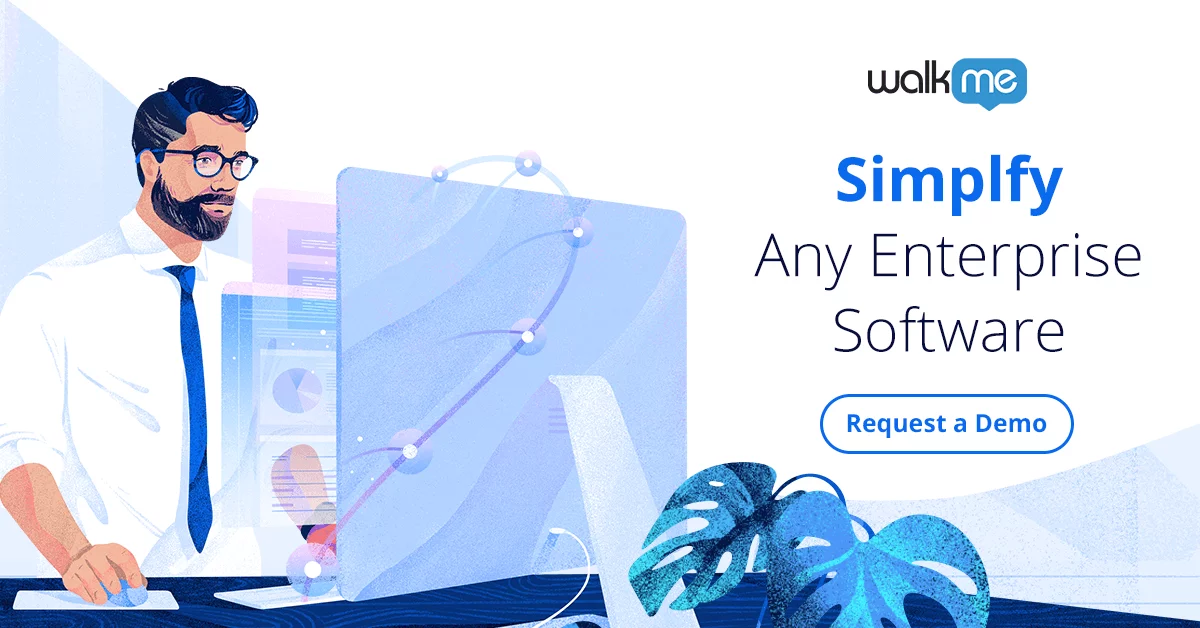WalkMe for Oracle Cloud HCM is the ideal solution for organizations that want to improve employee competency, productivity, and engagement on their HCM platform.
Oracle Cloud’s HCM solution can deliver significant benefits to the HR professional and the organization.
To achieve those benefits, though, users must become proficient and confident on when using the tool independently.
With a platform as feature-rich and complex as Oracle Cloud HCM, an effective digital adoption strategy is an absolute must.
 In other words, businesses should strategically focus on:
In other words, businesses should strategically focus on:

Enterprises that use WalkMe for Oracle Cloud HCM will reap large rewards when it comes to user productivity.
Benefits of the WalkMe platform include:
3 obstacles to effective digital adoption
Digital disruption and innovation are driving continuous change in today’s workplace. It is certainly true that technology can fuel growth and innovation. Yet, at the same time, technology itself can prove to be a major obstacle to employee productivity. There are a few reasons why:- Enterprise technology is complex, and today’s workers must learn to use a wide range of tools to stay productive.
- New tools and feature updates are released frequently, requiring users to continually learn new workflows and processes.
- In this type of business environment, effective training is not just a luxury – it is a core driver of business value.
 In other words, businesses should strategically focus on:
In other words, businesses should strategically focus on:
- Maximizing user proficiency – User competence determines user productivity and contributes to overall software ROI.
- Improving the user experience – The end user’s experience affects training effectiveness, knowledge retention, cognitive load, and other factors that contribute to their productivity and proficiency.
- Enhanced training – Training effectiveness impacts learning curves, time-to-competence, user productivity, and many other critical business metrics.
- Using software to its fullest extent – Software generates returns in proportion to its usage, so training should promote feature adoption and learning new workflows.
How to improve productivity and proficiency in Oracle Cloud HCM
As mentioned, user proficiency and productivity contribute directly to a software’s return on investment.There are a few ways to improve productivity and proficiency, such as: Streamlining the user experience. The user experience plays a big role in onboarding, training, and digital adoption. Good experiences positively impact employee learning, knowledge retention, proficiency, and productivity levels, among other things. Agile training and onboarding. A user-driven approach to onboarding and training will be more responsive, reactive, and effective. They will deliver better training results at a lower cost, which will ultimately drive up the value of the software investment. A culture of self-reliance. With the right tools and information, users won’t need to call on technical support. Digital Adoption Platforms, covered below, can help foster an organizational culture built around independence, self-sufficiency, and self-service. Such a culture will be more proactive and more productive with their digital tools. An effective digital adoption strategy is essential to achieving these aims … and a digital adoption platform is the key technology that enables true digital adoption.When users drop off before they complete a process, it often means lost revenue, wasted time and decreased employee #productivity. We conducted a study of 171 companies and over 117,000 users of leading #CRM and #HCM platforms. See the results:https://t.co/n96SPfnc9O
— WalkMe (@WalkMeInc) May 5, 2019

How Digital Adoption Platforms streamline the user experience
Digital Adoption Platforms (DAP), pioneered by WalkMe, are tools that streamline the user experience, enhance training, and improve software ROI. WalkMe’s platform does this through: Contextualized guidance. In-app guidance, such as step-by-step instructions and context-based engagement, offers help at the moment of need. This form of training streamlines users’ workflows and outperforms other training approaches. Task automation. In addition to its training functionality, WalkMe’s platform can automate tedious, repetitive tasks. This frees up employee time for more productive activities. User and software analytics. Understanding user behavior helps managers understand stumbling blocks and training needs. This information helps them design more effective training that meets the needs of users… and improves the results of software training. This innovative approach to user training has far-reaching impacts for today’s digital workplace. WalkMe for Oracle Cloud HCM: 5 benefits
WalkMe for Oracle Cloud HCM: 5 benefits
Enterprises that use WalkMe for Oracle Cloud HCM will reap large rewards when it comes to user productivity.
Benefits of the WalkMe platform include:
- Promoting software proficiency. Specific product features or workflows can be encouraged, depending on the needs of the organization.
- Boosted competency and time-to-competency. WalkMe’s in-app guidance cuts training time and training costs. At the same time, the contextualized nature of this training approach improves knowledge retention and competency levels.
- Streamlined workflows. Users with access to immediate guidance will be able to complete tasks more quickly than if they have to call for technical support. This decreased lag time is one way that WalkMe helps to create smoother workflows and improve the end user’s experience.
- Accelerated training time and reduced training costs. WalkMe’s in-app training solution transforms the entire training cycle, from onboarding to workflow guidance. The results include shortened learning curves, decreased training times, lower training costs, and better training outcomes.
- Insights into user behavior and errors. Analytics tell managers how users interact with software. This information can then be used to improve training, pinpoint obstacles, implement corrective action, and more.

